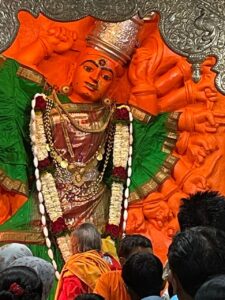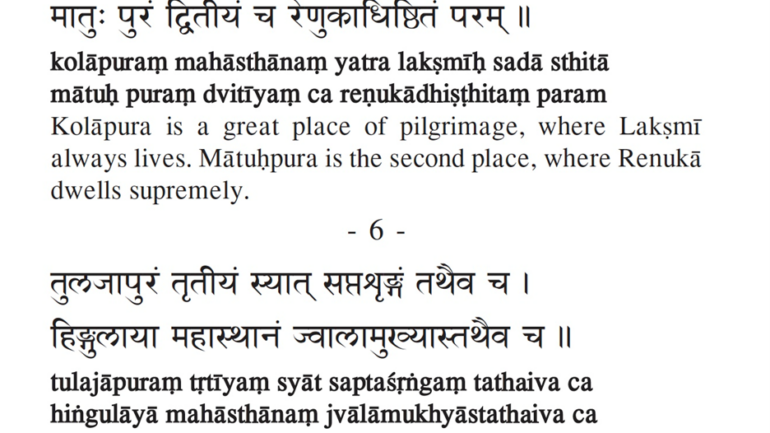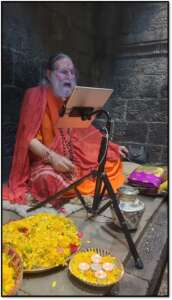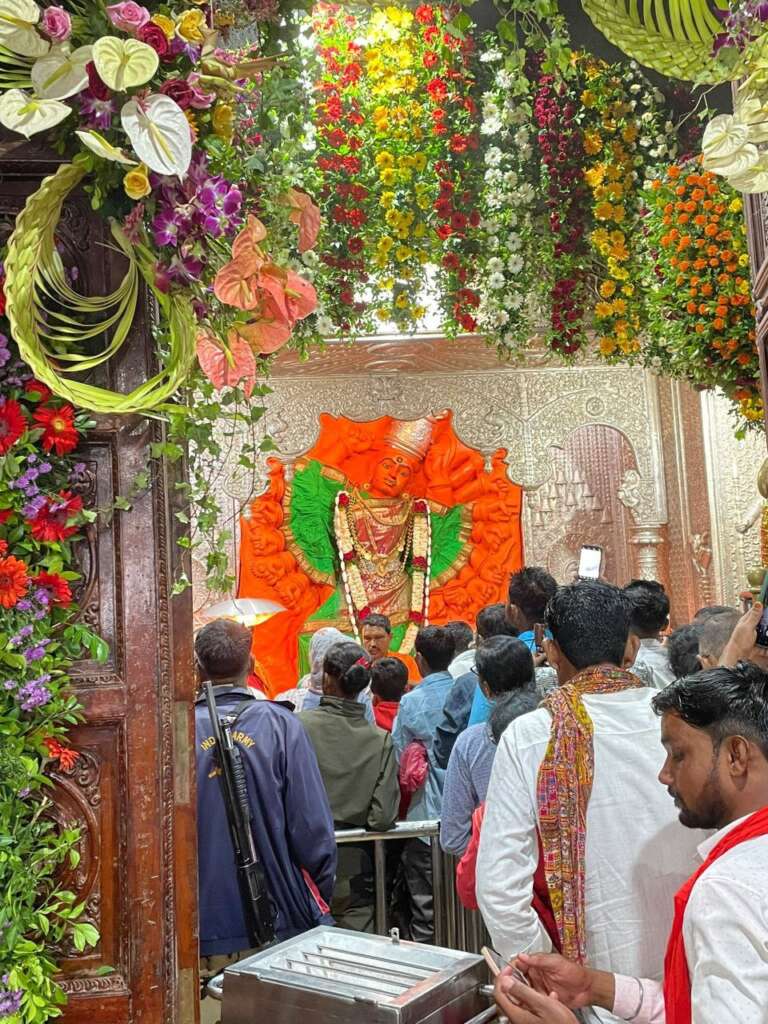
 We enjoyed the last few days visiting Kolhapur and Tulajapur, with a side trip to Akkalkot, where we made puja in the Temples, and chanted from the Chandi. I want to share with you the joy of darshan as well as the differences between the different kinds of temples – older and newer.
We enjoyed the last few days visiting Kolhapur and Tulajapur, with a side trip to Akkalkot, where we made puja in the Temples, and chanted from the Chandi. I want to share with you the joy of darshan as well as the differences between the different kinds of temples – older and newer.
Chapter Ten of the Devi Gita says:
 Kolhapur is known as a Mahalakshmi Temple, but it is actually a Temple for Chandi, Mahishasura Mardini, Mahakali and Mahasaraswati as well. Within the one mandap are shrines for the three Goddesses of the Chandi, and so it was very moving to us to be in a place in harmony with our tradition.
Kolhapur is known as a Mahalakshmi Temple, but it is actually a Temple for Chandi, Mahishasura Mardini, Mahakali and Mahasaraswati as well. Within the one mandap are shrines for the three Goddesses of the Chandi, and so it was very moving to us to be in a place in harmony with our tradition.
The priest said the temple had been established by Shankaracharya, but that appears to be a convenient tale told by pujaris picking a well know name from past history and attributing the work to him. Actually the temple’s establishment dates much prior to 700 AD, which is the time of Adi Shankara. Inside the temple the columns supporting the roof structure were placed approximately 4 feet apart, because at the time of construction they didn’t have the technology to span a greater distance, so the interior of the temple became a series of passage ways moving between pillar to pillar in order to visit the various shrines under one roof.
The floor was very uneven, and every few feet there was another step up or down, making visitors to look where we walked to avoid falling in a seemingly random change of elevation. This created a number of alcoves, perfectly suited to sitting in asana for puja, path, and japa, which were protected by the pillars on the sides. Unfortunately, there was no photography allowed inside, so we can’t show just how intricate was the layout.
We selected a beautiful alcove by the side of the entrance to Mahasaraswati’s Temple, where we made our asanas, and recited the Lalitha Trishati.
As this is a temple in a rural area and off the beaten path, it seemed that very few local people had previous contacts with foreign sadhus, and a crowd quickly gathered and eagerly listened to our recitation with great amazement. The alcove was well protected, and created an echo for the sound to resonate through the pillars, and it was really a joy to be in such an ancient place of pilgrimage, surrounded by devotees, chanting to our hearts’ content.
There is a feeling of performing the same sadhana that the rishis performed, in the same way that they performed it, in the same place in which they performed it, with the same ambience which surrounded their environment; doesn’t it feel also that these scriptures were written for us, about us, that we, too, are entitled to the same blessings as they received?
To me it feels like thousands of years ago, some rishis wrote these scriptures with the thought that some thousands of years in the future, some new rishis will come to visit these places to perform the sadhana that we performed in the way in which we performed it, and they will translate our understanding into the vernacular of their time, and find what we found while passing it on to the next generations.
That was the joy I experienced in Kolhapur!
Akkalkot is the main seat of worship for Swami Samarth, a predecessor of Sai Baba, who lived in the area somewhere between 1858 to 1878. Even though he taught the philosophy that the ultimate goal of human life is to realize one’s true nature as the Divine Self and to experience oneness with the Supreme Reality, he was best known as a performer of miracles and as someone who could cure disease.
The temple is around a hundred years old, built around a large banyan tree, where Swamiji used to sit for satsangha to discourse with his disciples, and it was very crowded with pilgrims seeking some material advantage for their lives or a cure for their physical ailments. We didn’t observe any sadhus sitting for meditation or chanting, so we bowed down to the altar, made an offering, and departed for Tulajapur.
Tulajapur is located on a side of the mountain top, and the town built around the temple has become the administrative seat of the county government. There are many stairs descending to the temple constructed some time in the 12th century in honor of Goddess Bhavani. She is the Eight Armed form of Durga, and the Chandi Path is frequently recited.
Feeling right at home amidst our tradition, upon request the priest led us to a suitable spot from where we could have darshan while we performed the puja and chanted to the Goddess.
Durga Maa in the form of Tulajapur Bhavani, got up and danced with us!

We made offerings and chanted, and everyone delighted in Darshan of the Divine Mother Goddess. We made offerings and chanted, and everyone delighted in Darshan of the Divine Mother Goddess.

Maharashtra is truly the “Great State.” We previously shared our visit to SaptaShringi, and we have shared about Tryambakeshwar, Ghusmeshwar, the Ajanta-Ellora and Kailash Caves, and our own Devi Mandir in Nashik and Napeshwar Ashram at Ghoti.
Soon we will depart for Kamakhya to perform the Navaratri, and I am sure we will have many more stories to share.
